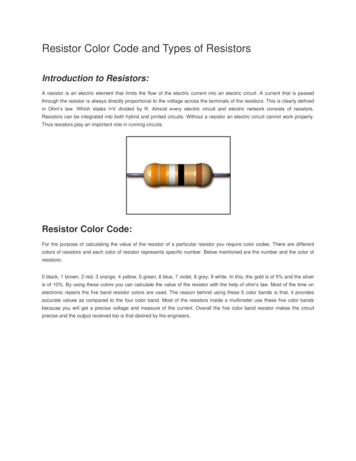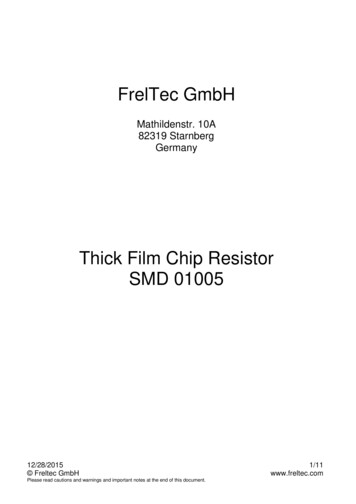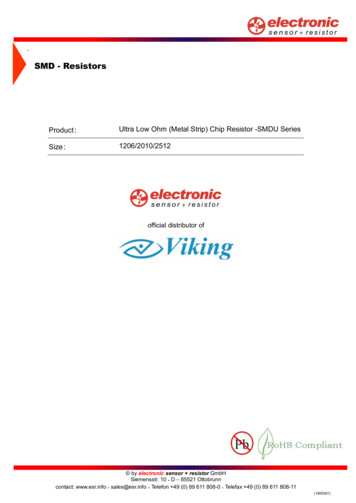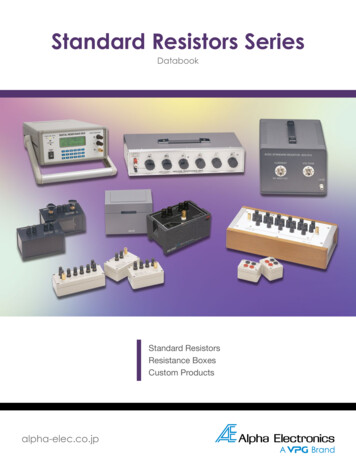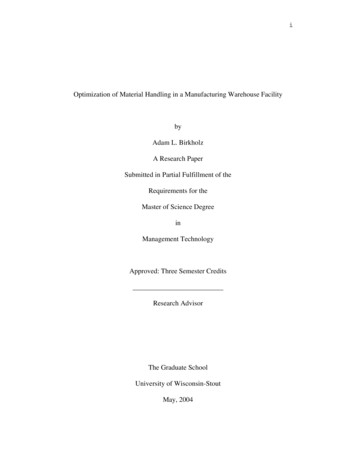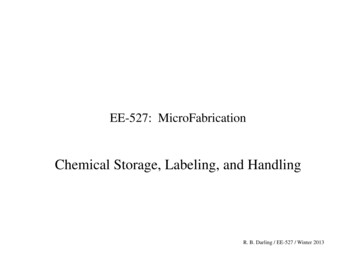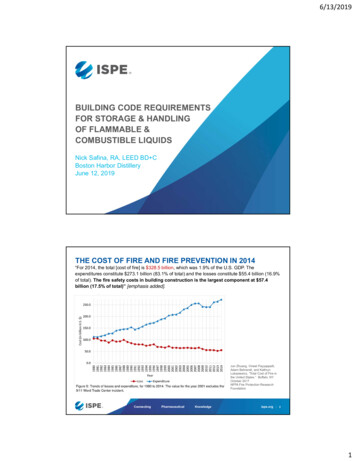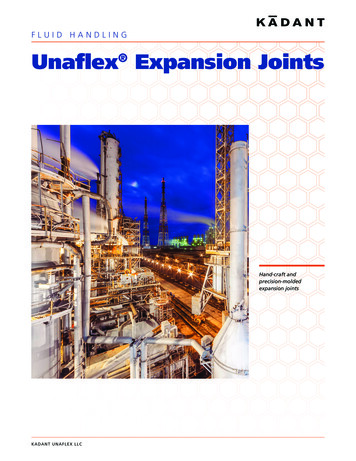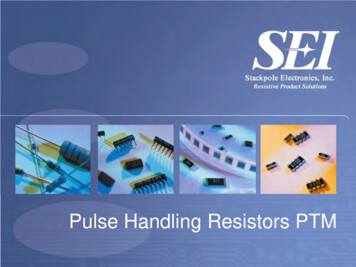
Transcription
Pulse Handling Resistors PTM
IntroductionPurposeTo explain the characteristics and tradeoffs for pulsehandling resistorsObjectivesTo provide an overview of the unique materials, design,and processes used to build pulse voltage and pulsepower handling resistorsContent21 pagesLearning Time20 minutesWelcome to Stackpole’s pulse handling resistor solutions product training module.This training module will provide a foundation to help design engineers understandthe strengths and limitations of resistors designed to withstand high voltage pulsesand those designed to withstand high power pulses.
OverviewPulse definitions and typesHigh Voltage Resistor TechnologiesAxial Leaded ResistorsSMD Chip ResistorsHigh Power Resistor TechnologiesAxial Leaded ResistorsCarbon CompositionWirewoundSMD Chip ResistorsConclusionSurge handling for electronic products is becoming more and more important withincreased electronic content. In many cases, legacy designs simply used the biggestor most robust resistor that would fit. Now that many of those designs are becomingobsolete or at least are being redesigned, there is an opportunity for downsizing andcost reduction if the proper pulse handling resistor is chosen.
Repetitive Pulse Definitions and TypesIn addition to these pulse types,resistors regularly encounterexponential rise or decay suchas from a capacitor charge ordischarge.Typically resistor pulse testing isdone with a square wave ofvarying duration.Single pulse ratings are morecommon for a majority of resistortypes; only pulse withstandingresistors are characterized forcontinuous pulse operation.Pulse events can occur from a wide variety of sources. Power IC’s turning on and off, inductive loadswitching, lightning and ESD are a few of the most common. The pulse shapes and repetition rates areequally varied. Many different types of pulse handling resistors exist because of this. It is important tounderstand the strengths and weaknesses of each technology in order to select theproper component for a particular application.
Single Pulse DefinitionsPulse TypeParameter measuredApplication1.2/50 usVoltage, currentGeneral10 / 700 usVoltage, energyGeneral8/20 usVoltage, currentGeneral10/350 usVoltage, currentIndustrial7/100 usVoltage, currentTelecom2-7 nsVoltage, currentESD10/400 msVoltgage, currentAutomotiveCurrent in percent of peak valueDefinition of PulseCurrent WaveformT1/T2 s10090Peak current (A)5010Virtual start of waveT2 Impulse durationVirtual front durationT1 1,25 x rise time from 10 % to 90 %Single pulse waveforms are most commonly described as the ratio of rise time from zero to peakamplitude over the time to decay to ½ the peak amplitude. Of the pulses shown in the above table, thefirst two are most commonly used for lightning pulse withstanding for resistors, in accordancewith IEC 60115-1.
High Voltage Leaded Resistors - RNVThe RNV is a high voltage withstanding axial leadedfilm resistor with robust environmental performance.Rated for 1600 volts working voltage and 3200volts max overload voltageWithstands 50 surges from a 1nF capacitorcharged to up to 10KV, 12 discharges per minutewith less than 1% resistance shiftIs designed for high temperature withstandingwith low resistance shiftCan reliably be used in high humidity applicationswith no risk of corrosion or failureHowever the RNV is only available in ¼ wattpower rating at this timeStackpole developed the RNV in response to increased customer demand for a robust film resistor that canwithstand surge events and harsh environmental conditions. For higher voltages, power ratings, orresistance values, other products must be considered.
RNV Voltage Handling CapabilityMaximum working voltage for the RNV14 is 1600 VDC, and overload voltageis 3200 VDC. Typical working voltage on a metal film resistor this size wouldbe 250 VDC and overload voltage would be 500 VDC.Per IEC60065.14.1 the RNV14 can withstand 50 surges of a 1nF capacitorcharged to Vmax, 12 discharges per minute, and must remain within 1% ofthe initial resistance value. The graph below shows the resistance valuedependent voltage for those surges.The RNV series metal film element is designed for high continuous voltage handling and high voltagesurge handling. This capability is critical in many types of power inverter applicationsand switching power supplies, such as AC power adaptors.
High Voltage Leaded Resistors –ASR / ASRM and MG / MGMMG / MGM series is metal glaze or thick film technologyWorking voltages from 1600 volts up to 3500 volts.Surge voltage handling up to 10KVPower ratings ½, 1, 2, and 3 wattsResistance values from 100K ohms up to 1G ohms.ASR / ASRM series are also metal film technologyWorking voltages from 1600 volts up to 5000 volts.Surge voltage handling up to 10KVPower ratings ¼, ½, and 1 wattsResistance values from 100K ohms up to 12Meg ohms.These two series offer a wider range of power ratings and resistance values, as well ashigher working voltages than the RNV. The MG and MGM offer high working andoverload voltages and the highest resistance values in an axial leaded part. The ASRand mini ASR have the highest working voltages and are specifically designed forhandling thousands of high voltage pulse events.
High Voltage SMD Resistors - HVCThe HVC is Stackpole’s high voltage chip resistorseriesSizes 0603, 0805, 1206, 2010, 2512, and 3512Resistance values up to 50G ohmsWorking voltages up to 3500 voltsSurge voltage handling up to 40KV with properterminal isolationHigh precision – TCR’s as low as 25 ppm andtolerances down to 0.1%Low VCR to 1ppm per voltThe HVC is Stackpole’s premier surface mount high voltage product. No other product currently availableoffers the high voltage handling, high pulse voltage handling, high resistance values, and tight precisionthat the HVC offers.
Pulse Voltage Performance DataHVC 2512 vs. Std Thick Film Chip Pulse Performance50004500400035003000VoltsThe data shown here is for a100K ohm resistance value,which is the lowest availablefor the HVC and the worstcase scenario for highvoltage pulse handling.HVC2500Std Thick Film20001500For resistance values at theupper end of the range,pulse handling up to 40KVcan be achieved.100050000.0010.020.040.060.08SecondsThe HVC series is able to withstand high voltage pulses better than thecompetition because of the superior and unique fine line process fordepositing the resistor on the substrate. This deposition method allowsfor lower voltage stress on the film per unit length.0.1
Axial Leaded High Pulse Power Resistors– RC Series Carbon CompositionCarbon Composition resistors have long beenknown for their outstanding pulse power andpulse energy handling. The 1 watt size carboncomp can handle up to 10J of energy.Inductance for carbon comps is extremely low,making them very popular for high speedswitching power supplies.Carbon comps are known to be susceptible toresistance shifts due to moisture, although theseeffects can usually be reversed through a hightemperature bake of the components.The RC series from Stackpole remains a popular choice for applications requiring high pulse power orpulse energy and low inductance. It has better pulse handling capacity than film based surgeresistors, lower inductance than wirewound based resistors and a broader resistance range as wellas lower cost than ceramic composition resistors.
RC14 and RC12 Carbon CompPulse Power PerformanceTest Conditions : 100 discharges of a 2.0 nF capacitor,10K ohm Resistance Value100 Ohm Resistance ValueFor short duration pulses, carbon composition resistors can withstand pulses of wellover 70,000 watts. The pulse power handling characteristic of carbon comps isresistance value dependent with higher values performing better, as demonstrated in
Axial Leaded High Pulse PowerHandling Resistors - WirewoundsWirewound resistors are also used for handlinghigh energy or high power pulses.Wirewound resistance elements are much morerobust than power film elements.Wirewounds can handle tens of thousands ofwatts safely and have no wear out mechanismdue to pulse handling; this makes them a greatchoice for repetitive pulse handlingrequirements.Wirewounds are inherently inductive. They canbe wound using non-inductive Ayrton Perrywindings, but may still have several nH ofinductance depending on the size and resistancevalue of the part.Welded wirewound elements are extremely reliable under long term repetitive pulse exposure. Theseelements can also be designed to maximize the pulse power handling by choosing the ideal wire tomaximize the element mass and by limiting the calibration trimming operation.
Pulse Energy Handling Capacity For AxialLeaded WirewoundsWirewound Energy Handling CapacityPart NumberPower Rating (W)R - Value (ohms)Energy Capacity (J)WW10 4R70104.7495WWP10 2R00102164WW5 18R051818.2WWP4 50R045012.6WWH 300R0.53000.5SP3A 33R03333.1SP3A 100R31001.6Energy handling depends on the mass of wire used to build the resistor. While it is logical that largerresistors with higher power ratings will have better pulse handling, this isn’t always the case.For the WW10 part numbers, the 4.7 ohm value has much better energy handling since both partsuse the same wire.For the SP3A, the 100 ohm value requires a smaller diameter wire, limiting its energy handling.For applications that aren’t sensitive to inductance or have high switching speeds, wirewound resistorsoffer a good blend of robust pulse handling and relatively low cost. In addition, wirewounds can beadjusted to offer higher surge energy handling, lower inductance, higher voltage handling,and specialized fusing characteristics.
Wirewound Resistor Energy Handling ByResistance ValueEnergy Capacity SMP2615Energy (J)1010.10.010.010.1110100100010000Value (ohms)Wirewound resistors of any size have an ideal wire alloy and size to balancethe power handling, pulse handling, and inductance characteristicsMost wirewound resistors are designed to have 12 to 16 turns of wire from endto endMost size and value combinations however, allow for several different wires tobe used.The graph above shows wirewound pulse handling dependence on size and resistancevalue. The discontinuity points show where a smaller diameter wire is needed toachieve the higher resistance values. From those points to the next, the pulse handling
Pulse Power Withstanding ChipResistors - RPCRPC is designed specifically towithstand pulse current andpulse power events by limitingthe laser trimming allowed forcalibration.Current crowding occurs wherethe resistor is trimmed whichcreates a hot spot and limits theamount of pulse power the partcan withstand.General purpose thick film chips can have laser trims which reduce the width of the resistor element byup to 40%, which can greatly reduce the pulse handling of the device. This variability creates an equallyvariable pulse handling behaviour and makes using them for pulse applications risky.
RPC Series Pulse Handling100 ohm resistance values chosenas benchmark; pulse handling forlower resistance values may bebetter, while higher values may havereduced pulse handlingFor shorter duration pulses thanshown here, the pulse capabilitybegins to level offThe RPC series offers guaranteed pulse handling many times better than standard general purpose thickfilm chips. The RPC 5% tolerance has best in class pulse handling performance compared to surgehandling film chip resistors from leading competitors.
HPC Series Pulse HandlingThe HPC12 is constructed with 4parallel 2512 size thick film chipresistor elements attached to anextruded aluminium heat sinkhousingThe HPC12 is rated for 5 watts power handling in free air and has excellent pulse handling for pulsedurations of 0.01 seconds and longer. For shorter duration pulses, the RPC2512 5% tolerance is stillbetter and the RPC has guaranteed pulse withstanding.
Pulse Energy Handling Capacity forSurface Mount WirewoundsSurface Mount Wirewound Energy CapacityPart numberPower Rating (W)Resistance Value (ohms)Energy Capacity (J)SM2615 1R00111.7SM2615 10R01100.7SM4124 1R00212.7SM4124 10R02101.6SM6227 1R003117.2SM6227 10R03107.0SM8035 1R004143.3SM8035 10R041016.8Pulse power handling for the SM series is up to 10KWWirewound technology offers a good blend of pulse power and pulse energy handling and relative low costfor applications which don’t have high switching speeds or sensitivity to inductance. Surface mountresistors that can handle up to 50J are rare, yet surface mount wirewounds can and arereadily available.
Pulse Handling Resistor SummaryPulse Withstanding Resistor SummaryAxial Leaded ResistorsProductPower Range(W)Resistance Range(ohms)Pulse VoltageCapability (V)Pulse PowerCapability (W)Pulse EnergyCapability (J)RNV1/4100K - 15M7KVNANAASR / ASRM1/4 - 110 - 12M10KVNANAMG / MGM1/4 - 3100K - 1G10KVNANARC1/4 - 11 - 22MNA 80K 10Wirewound1/2 - 25.01 - 150KNA 100K 500Surface Mount ResistorsProductPower Range(W)Resistance Range(ohms)Pulse VoltageCapability (V)Pulse PowerCapability (W)Pulse EnergyCapability (J)HVC0.06 - 310K - 50G40KVNANARPC0.1 - 1.51 - 20M 5KV 4400NAHPC5.0.025 - 250KNA 2560NASM1-40.01 - 5KNA 10K 50The above products utilize film, carbon composition, and wirewound resistortechnologies. Each product offers distinct advantages for its target applications. Byselecting the correct product, design engineers can downsize their designs, reduceweight, and reduce costs while maximizing the long termreliability of their end product.
ConclusionFor pulse voltage handling, film technologies can offer outstandingcharacteristics at relatively low cost.Pulse energy and pulse power handling however requireresistance element mass, making carbon composition andwirewound technologies a better choice.Stackpole’s axial leaded resistors have options which can handlepulse voltages up to 10KV, pulse power up to 80KW, and pulseenergy up to 500J.Stackpole’s surface mount resistors have products that can handlepulse vol
SMD Chip Resistors High Power Resistor Technologies Axial Leaded Resistors Carbon Composition Wirewound SMD Chip Resistors Conclusion . Repetitive Pulse Definitions and Types Pulse events can occur from a wide variety of sources. Power IC’s turning on and off, inductive load switching, lightning and ESD are a few of the most common. The pulse shapes and repetition rates are equally varied .
